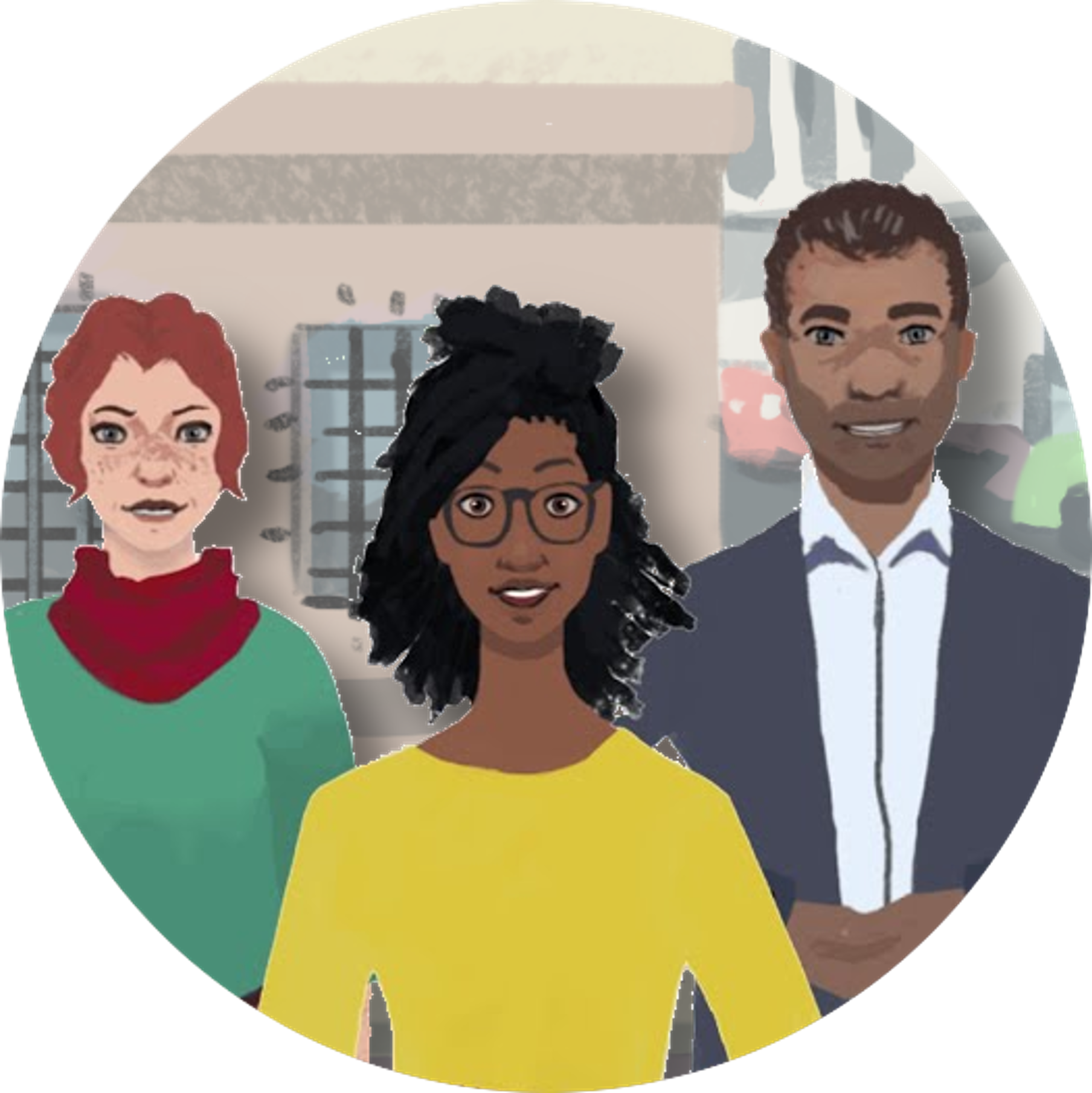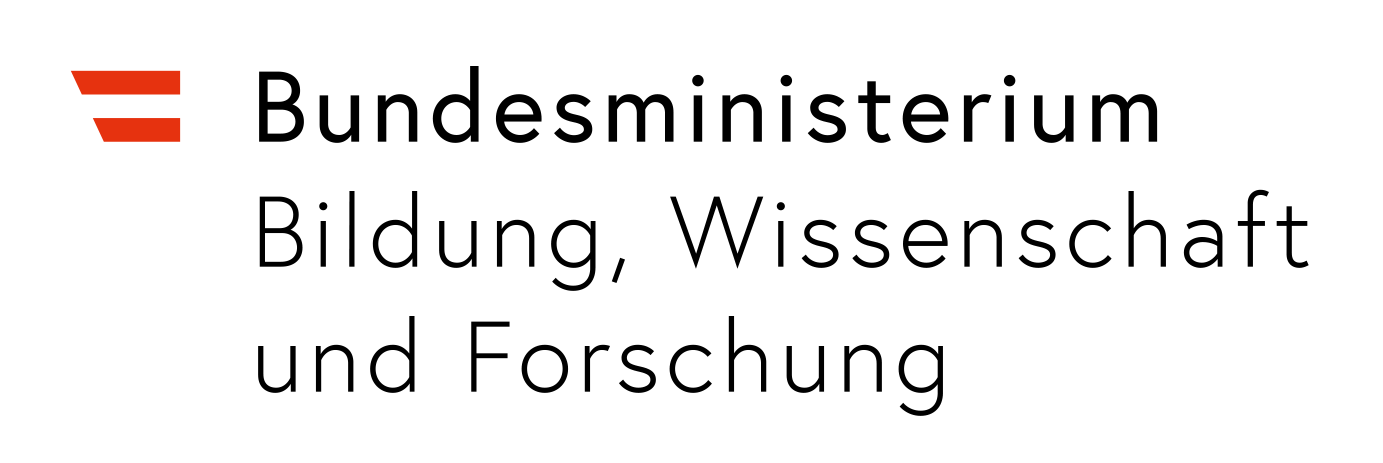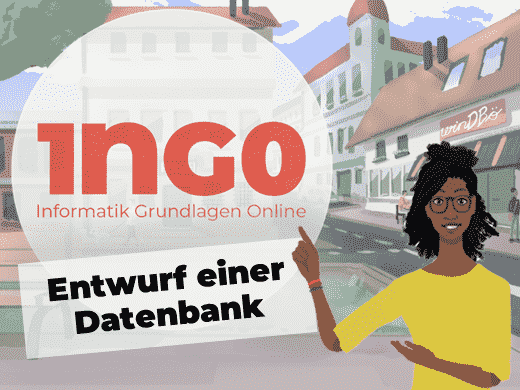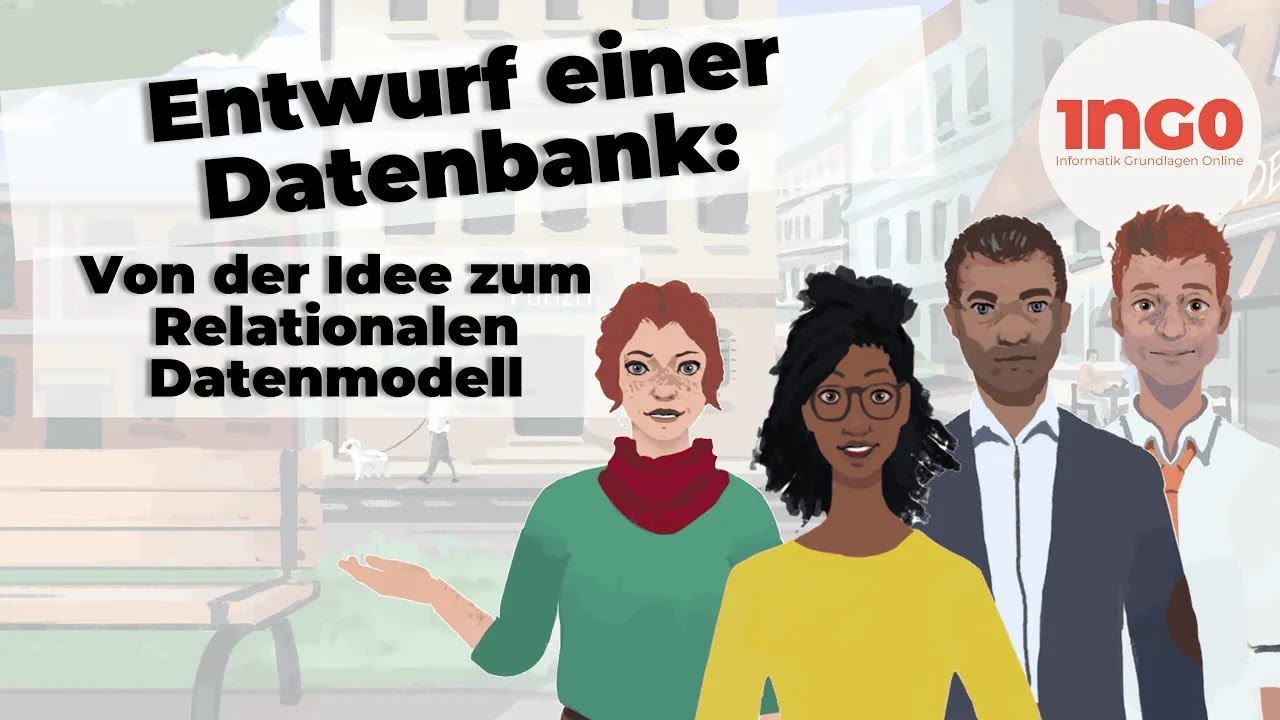Entwurf einer Datenbank: Von der Idee zum relationalen Datenmodell
Kursstart: 5. Februar 2024
Entwurf einer Datenbank: Von der Idee zum relationalen Datenmodell
Claudia Steinberger, Nina Lobnig
Wissenschaftliche Einordnung:
Kursstart: 5. Februar 2024
Entwurf einer Datenbank: Von der Idee zum relationalen Datenmodell
Claudia Steinberger, Nina Lobnig
-
Umfang: 6 Lektionen
-
Aufwand: 4 Stunden/Woche
-
Teilnehmende aktuell: 533
-
Lizenz: CC BY 4.0
-
Kursstart: 5. Februar 2024
-
Kursende: -
-
Status aktuell: Laufender Kurs
-
Verfügbare Sprachen:
Trailer
Details zum Kurs
Allgemeine Informationen zum Kurs
In diesem Kurs befassen wir uns mit Allerlei zum Entwurf von Datenbanken - von Allgemeinem zu Datenbanken (Was und wozu?) und zur Domänenanalyse, über die Modellierung mit UML Klassendiagrammen (Wie sieht ein konzeptueller Datenbankentwurf aus?) und der Transformation ins Relationenmodell (Wie werden die Relationen aussehen?), bis hin zur Qualität von Relationenschema (Was macht gute Relationen aus? Wo treten Probleme auf?).
Tauche in die Welt der Datenbanken ein,
erlerne Inhalte anhand von Geschichten! Darin erklären animierte Charaktere Inhalte
und deren Nutzung in konkreten Problemsituationen und finden in einer Kriminalinspektion und einer ansässigen Bäckerei
statt und haben immer einen Datenbank-Bezug. Die Inhalte umspannen den gesamten Entwurf einer Kriminal- und einer Bäckerei-Datenbank und stellen somit einen wichtigen Teil des Lebenszyklus einer Datenbank. Ein guter Entwurf legt den Grundstein für sinnvoll und praktikabel verwendbare Datenbanken und beugt Problemen vor!
Dabei werden die konzeptuellen und logischen Entwurfsschritte dieser Datenbanken begleitet und auf Probleme und Anomalien von schlecht entworfenen Datenbanken aufmerksam gemacht und erlernt, was gute Relationen ausmacht. Die Idee hinter diesem Kurs ist wegzukommen von einem typischen Lehr-Setting mit aufgezeichneten Vorträgen, hin zur aktiven Anwendung des vermittelten Wissens. Videos sind daher mit H5P-Elementen unterlegt, um die Interaktivität zu erhöhen und Wissen gleich zu festigen. Auch die zugehörigen Aufgaben sind spannend gestaltet und in Geschichten eingebettet. Helft unseren beiden Inspektor*innen bei der Anwendung des zuvor Gehörten und zeigt, was ihr schon drauf habt!
Unsere Inhalte, wie Videos, interaktive Bücher, PDFs und mehr, sind für alle konzipiert: Schüler*innen, Studierende und auch alle andere Interessierten.
Kursinhalt
Was erwartet euch im Kurs? Welche Inhalte kommen darin vor?
Einen kurzen Überblick erhaltet ihr im oben angezeigten Video.
Aufbau des Kurses:
Der MOOC gliedert sich in mehrere Lektionen - das sind sechs wissenswerte Schritte in die Welt der (relationalen) Datenbanken:
Lektion 1: Überblick über die Inhalte, den Aufbau und die Materialien im MOOC
Lektion 2: Einführung in die Welt der Datenbanken
Lektion 3: Basiskonzepte des konzeptuellen Entwurfs (mit UML Klassendiagrammen)
Lektion 4: Erweiterte Konzepte des konzeptuellen Entwurfs (wie Generalisierung, Aggregation und Komposition)
Lektion 5: Entwurf einer relationalen Datenbank (Transformation ins Relationenmodell)
Lektion 6: Schemaqualität und Normalformen
Hinweis: Die oben angegebene Lernzeit pro Lektion ist geschätzt und ergibt sich, wenn in den Lektionen alle Themen und vertiefenden Beispiele (Aufgaben) vollständig durchgearbeitet werden. Bei entsprechendem Vorwissen kann sich diese wesentlich verkürzen. Es ist auch möglich nur einzelne Lektionen oder Inhalte des MOOC zu bearbeiten. In diesem Fall kann jedoch kein Teilnahmezertifikat ausgestellt werden.
Lernziele
- Eigenschaften, Architektur und Datenmodelle von Datenbanksystemen kennenlernen
- Phasen der Datenbankentwicklung aufzählen und die nötigen Schritte kurz beschreiben können
- Eine Datenbank konzeptuell entwerfen können (mittels UML Klassendiagramm)
- Ein Relationenmodell aus einem konzeptuellen Datenbank-Entwurf ableiten können
- Daumenregeln für gute Relationenschema nennen können und auftretende Anomalien kurz beschreiben und beheben können
- Erste bis dritte Normalform kennenlernen und die Normalform eines gegebenen Schemas bestimmen können
Vorkenntnisse
Für diesen Kurs sind keine speziellen Vorkenntnisse nötig. Ausgenommen davon sind herkömmliche Fähigkeiten im Umgang mit dem Computer, sowie damit verbundener Software (inkl. Herunterladen und Installieren von Software) und das Verwenden von Webanwendungen.
Kursablauf
Jede Lektion startet mit der Nennung von zentralen Inhalten, die in dieser Lektion behandelt werden und nennt Fragen, die nach Abschluss der Lektion beantwortet werden können. Wenn wir in einer Lektion eine Übungsumgebung vorschlagen, gibt es dazu ebenfalls genaue Informationen, bevor es so richtig los geht. Je nach Umfang besteht eine Lektion aus einem oder mehreren Themen.
Wir verfolgen in diesem MOOC mit den Domänen der Polizeiinspektion und der Bäckerei einen besonders angewandten Lernzugang. Daher starten Themen meist mit einer praktischen Fragestellung, die als Herausforderung gedacht ist und nach Durcharbeiten des Themas lösbar sein sollte. Das ist das sog. 'Einstiegsbeispiel'. Sind evtl. durch Vorerfahrungen die notwendigen Kompetenzen schon vorhanden, wird das bereits hier schon klar.
Es gibt verschiedene Typen von Lernobjekten. Jene, die Basiswissen zu einem Thema vermitteln ('Was ich zum Thema wissen sollte'), jene, die Anwendung dieses Basiswissens an Hand von Beispielen zeigen ('Anwendung der erlernten Konzepte an Beispielen') und auch Aufgaben zur Anwendung des Gelernten ('Wissensvertiefung'). Dabei kann es sich um kurze Videos (mit Charakteren unserer Polizeiinspektion), um interaktive Bücher oder Texte handeln. Die Reihenfolge der Lernobjekte ist zwar fachlich aufeinander aufbauend, kann jedoch je nach Bedarf konsumiert werden.
Jede Lektion schließt mit einem Lektionsquiz ab. 75 % der erforderlichen Punkte sind für die positiven Abschluss der Lektion (und das Teilnahmezertifikat am Ende) notwendig. Dabei gibt es insgesamt fünf Versuche.
Zertifikat
Für die aktive Teilnahme am Kurs erfolgt bei Abschluss die Ausstellung eines automatisierten Zertifikats, welches Ihren Benutzernamen, den Kursnamen und die abgeschlossenen Lektionen beinhalten. Es wird darauf hingewiesen, dass es sich nur um eine Bestätigung handelt, die aussagt, dass der*die Benutzer*in zumindest 75% der gestellten Selbstüberprüfungsfragen richtig beantwortet hat.
Lizenz
Dieses Werk ist lizenziert unter Creative Commons - 4.0 International (CC BY 4.0) Universität Klagenfurt.
Kursleitung
Claudia Steinberger, Nina Lobnig
Dieser MOOC wurde vom bmbwf im Rahmen des Projektes eInformatics@Austria gefördert (Digitale und Soziale Transformation in der Hochschulbildung, 2020-2024). Ziel des Projektes ist die Entwicklung von MOOCS zur Vermittlung von Informatik Grundlagen Online (1ngO) und dieser Kurs deckt einen Teil des Themas 'Datenbanken' ab und wurde vom Projektteam aus Klagenfurt erstellt.
Hauptverantwortliche für beide Kurse sind Claudia Steinberger und Nina Lobnig, die von ihren Mitarbeiter*innen tatkräftig unterstützt wurden.
Als sinnvolle Ergänzung empfehlen wir, nachfolgend den MOOC "Datenbanken: Entdecke die Welt von SQL" auch zu absolvieren.

Sam Winter, Lara Fischer und Amar Kovač
Durch den Kurs begleiten werden Euch unsere fiktiven Charaktere Sam Winter, Lara Fischer und Amar Kovač, die die Inhalte sowohl in der Theorie als auch in der Praxis vermitteln und an Beispielen anschaulich zeigen.
Sam Winter (mittig im Bild) ist Expertin für Datenbanken und führt in die verschiedenen Themen ein, erklärt alles Wichtige und zeigt die Inhalte auch an Beispielen. Dabei bringt sie oft Beispiele aus ihrer Lieblingsbäckerei, die sie bei der Umsetzung einer neuen Datenbank unterstützt, wie auch aus der Polizeiinspektion, mit der sie auch zusammenarbeitet.
Lara Fischer (links im Bild) und Amar Kovač (rechts im Bild) sind zwei Ermittler*innen aus der Polizeiispektion und stehen im Austausch mit Expertin Sam. Sie wenden die eingeführten Inhalte in ihrem Berufsalltag an.
An der Konzeption und Erstellung des MOOCs und der Inhalte mitgearbeitet haben (alle von der Universität Klagenfurt, alphabetisch aufgeführt):
- Nicole Burgstaller
- Nina Lobnig
- Michael Morak
- Claudia Steinberger
- Claudia van der Rijst
- Anna-Sophie Wallner
- Aron Wedam
- Markus Wieser
- Andreas Bollin (didaktische Beratung)
Die Charaktere, Hintergründe und Objekte wurden eigens dafür gezeichnet und animierbar gestaltet. Hierbei beteiligt waren:
- Jan Jancik (Beratung, Rigging, Intro und Outro)
- Stefan Pesendorfer (Beratung sowie Zeichnungen)
- Wolfgang Neipl
- Nessa Heschmat
Fragen oder Anmerkungen?
Nutze das Forum im Kurs oder schreibe uns gerne eine Mail an: 1ng0@aau.at
(Achtung: Die Mailadresse enthält zwei Ziffern.)
Partner:innen
 bmbwf
bmbwf
Dieser MOOC wurde vom bmbwf im Rahmen des Projektes eInformatics@Austria(Digitale und Soziale Transformation in der Hochschulbildung, 2020-2024) gefördert. Ziel des Projektes ist die Entwicklung von MOOCS zur Vermittlung von Informatik Grundlagen Online (1ngO) und dieser Kurs deckt einen Teil des Themas 'Datenbanken' ab.
-

Universität Klagenfurt


